The Impact of Toxic Work Culture in Hospitals on Social Work Practice
VerifiedAdded on 2022/09/16
|9
|2444
|15
Essay
AI Summary
This essay examines the pervasive issue of toxic work culture within hospital environments and its significant implications for social work practice. The essay delves into the detrimental effects of such cultures, including increased stress levels, reduced job satisfaction, and potential burnout among healthcare professionals, particularly social workers. It highlights how factors such as incivility, bullying, excessive workloads, and power imbalances contribute to a toxic atmosphere. The essay draws on various research studies and reports to illustrate the negative impact on employee well-being, patient care, and the overall effectiveness of hospitals as human service organizations. It also explores the role of social workers in addressing and mitigating the effects of toxic work culture, including the importance of recognizing and responding to workplace bullying, offering support to affected individuals, and advocating for organizational-level changes to foster a healthier and more supportive work environment. Finally, the essay considers the need for changes in traditional professional education to address the issue of workplace toxicity in the healthcare sector.
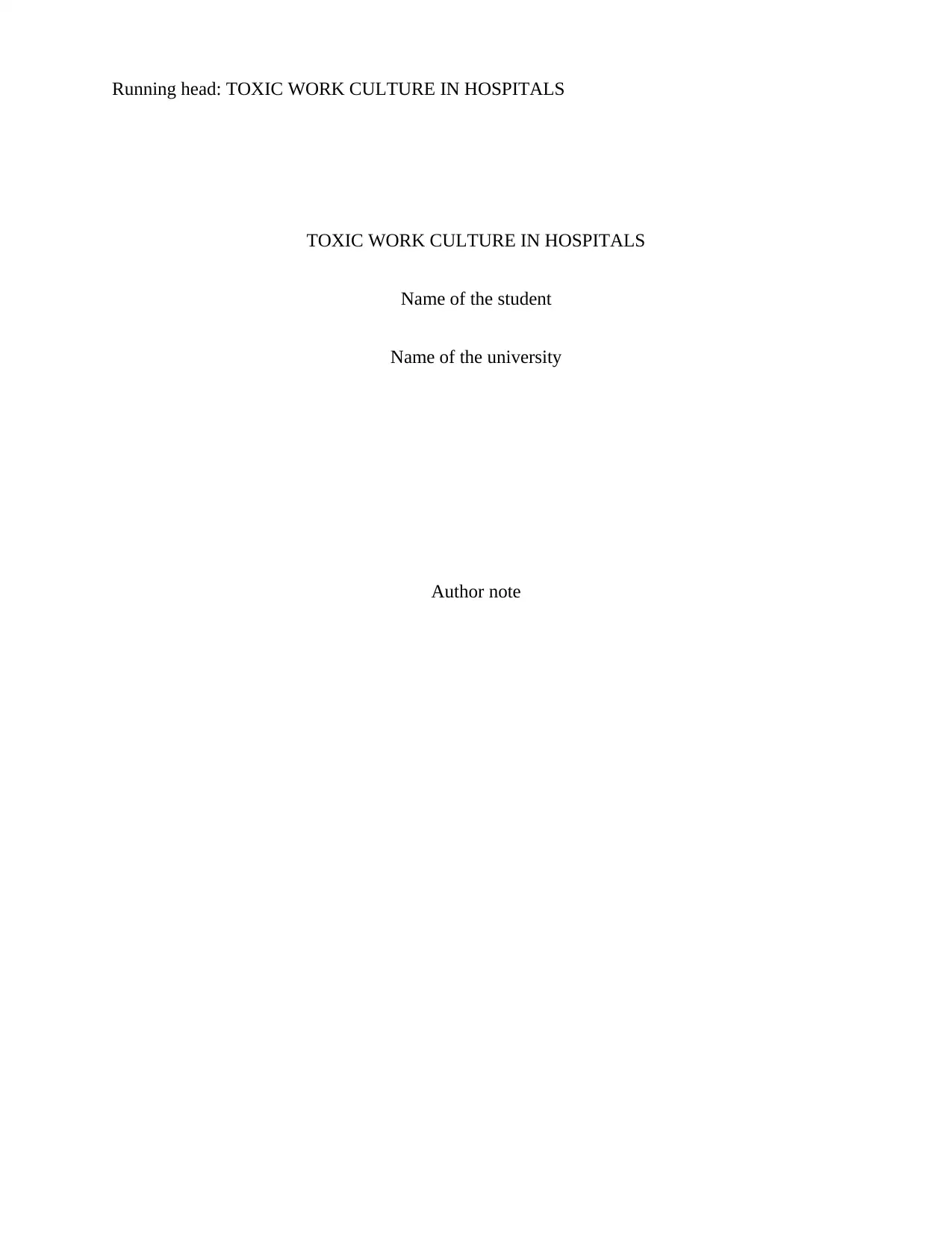
Running head: TOXIC WORK CULTURE IN HOSPITALS
TOXIC WORK CULTURE IN HOSPITALS
Name of the student
Name of the university
Author note
TOXIC WORK CULTURE IN HOSPITALS
Name of the student
Name of the university
Author note
Paraphrase This Document
Need a fresh take? Get an instant paraphrase of this document with our AI Paraphraser
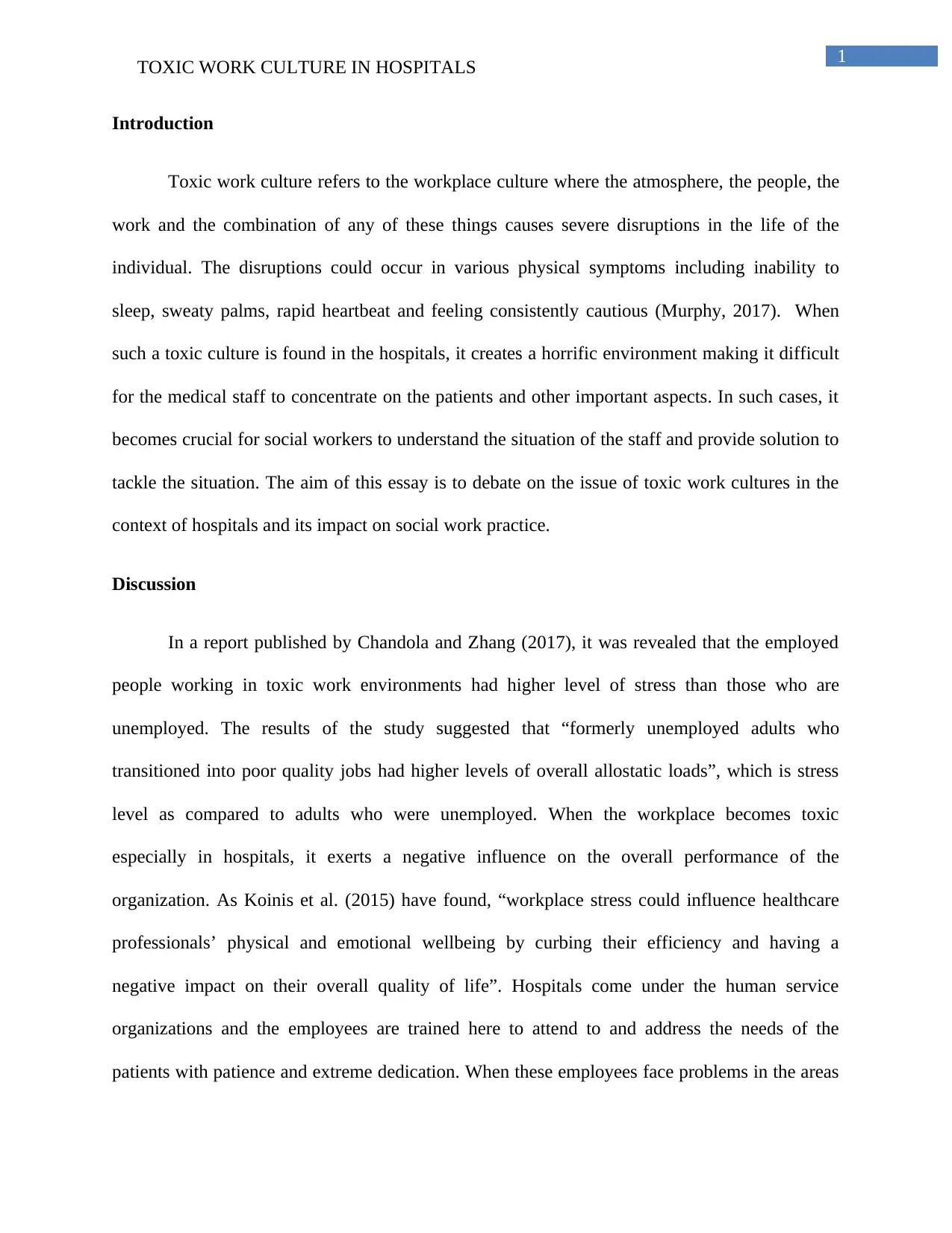
1
TOXIC WORK CULTURE IN HOSPITALS
Introduction
Toxic work culture refers to the workplace culture where the atmosphere, the people, the
work and the combination of any of these things causes severe disruptions in the life of the
individual. The disruptions could occur in various physical symptoms including inability to
sleep, sweaty palms, rapid heartbeat and feeling consistently cautious (Murphy, 2017). When
such a toxic culture is found in the hospitals, it creates a horrific environment making it difficult
for the medical staff to concentrate on the patients and other important aspects. In such cases, it
becomes crucial for social workers to understand the situation of the staff and provide solution to
tackle the situation. The aim of this essay is to debate on the issue of toxic work cultures in the
context of hospitals and its impact on social work practice.
Discussion
In a report published by Chandola and Zhang (2017), it was revealed that the employed
people working in toxic work environments had higher level of stress than those who are
unemployed. The results of the study suggested that “formerly unemployed adults who
transitioned into poor quality jobs had higher levels of overall allostatic loads”, which is stress
level as compared to adults who were unemployed. When the workplace becomes toxic
especially in hospitals, it exerts a negative influence on the overall performance of the
organization. As Koinis et al. (2015) have found, “workplace stress could influence healthcare
professionals’ physical and emotional wellbeing by curbing their efficiency and having a
negative impact on their overall quality of life”. Hospitals come under the human service
organizations and the employees are trained here to attend to and address the needs of the
patients with patience and extreme dedication. When these employees face problems in the areas
TOXIC WORK CULTURE IN HOSPITALS
Introduction
Toxic work culture refers to the workplace culture where the atmosphere, the people, the
work and the combination of any of these things causes severe disruptions in the life of the
individual. The disruptions could occur in various physical symptoms including inability to
sleep, sweaty palms, rapid heartbeat and feeling consistently cautious (Murphy, 2017). When
such a toxic culture is found in the hospitals, it creates a horrific environment making it difficult
for the medical staff to concentrate on the patients and other important aspects. In such cases, it
becomes crucial for social workers to understand the situation of the staff and provide solution to
tackle the situation. The aim of this essay is to debate on the issue of toxic work cultures in the
context of hospitals and its impact on social work practice.
Discussion
In a report published by Chandola and Zhang (2017), it was revealed that the employed
people working in toxic work environments had higher level of stress than those who are
unemployed. The results of the study suggested that “formerly unemployed adults who
transitioned into poor quality jobs had higher levels of overall allostatic loads”, which is stress
level as compared to adults who were unemployed. When the workplace becomes toxic
especially in hospitals, it exerts a negative influence on the overall performance of the
organization. As Koinis et al. (2015) have found, “workplace stress could influence healthcare
professionals’ physical and emotional wellbeing by curbing their efficiency and having a
negative impact on their overall quality of life”. Hospitals come under the human service
organizations and the employees are trained here to attend to and address the needs of the
patients with patience and extreme dedication. When these employees face problems in the areas
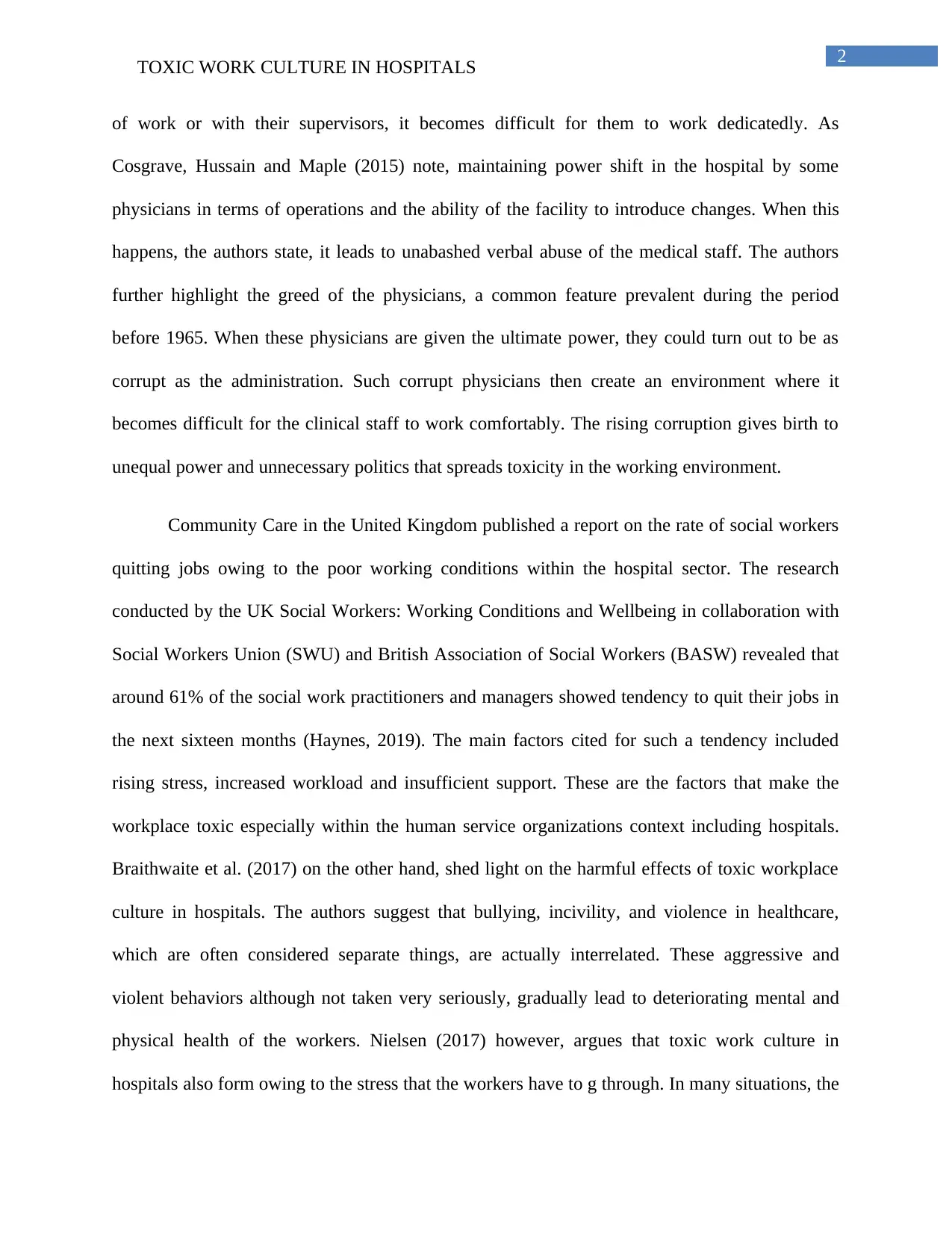
2
TOXIC WORK CULTURE IN HOSPITALS
of work or with their supervisors, it becomes difficult for them to work dedicatedly. As
Cosgrave, Hussain and Maple (2015) note, maintaining power shift in the hospital by some
physicians in terms of operations and the ability of the facility to introduce changes. When this
happens, the authors state, it leads to unabashed verbal abuse of the medical staff. The authors
further highlight the greed of the physicians, a common feature prevalent during the period
before 1965. When these physicians are given the ultimate power, they could turn out to be as
corrupt as the administration. Such corrupt physicians then create an environment where it
becomes difficult for the clinical staff to work comfortably. The rising corruption gives birth to
unequal power and unnecessary politics that spreads toxicity in the working environment.
Community Care in the United Kingdom published a report on the rate of social workers
quitting jobs owing to the poor working conditions within the hospital sector. The research
conducted by the UK Social Workers: Working Conditions and Wellbeing in collaboration with
Social Workers Union (SWU) and British Association of Social Workers (BASW) revealed that
around 61% of the social work practitioners and managers showed tendency to quit their jobs in
the next sixteen months (Haynes, 2019). The main factors cited for such a tendency included
rising stress, increased workload and insufficient support. These are the factors that make the
workplace toxic especially within the human service organizations context including hospitals.
Braithwaite et al. (2017) on the other hand, shed light on the harmful effects of toxic workplace
culture in hospitals. The authors suggest that bullying, incivility, and violence in healthcare,
which are often considered separate things, are actually interrelated. These aggressive and
violent behaviors although not taken very seriously, gradually lead to deteriorating mental and
physical health of the workers. Nielsen (2017) however, argues that toxic work culture in
hospitals also form owing to the stress that the workers have to g through. In many situations, the
TOXIC WORK CULTURE IN HOSPITALS
of work or with their supervisors, it becomes difficult for them to work dedicatedly. As
Cosgrave, Hussain and Maple (2015) note, maintaining power shift in the hospital by some
physicians in terms of operations and the ability of the facility to introduce changes. When this
happens, the authors state, it leads to unabashed verbal abuse of the medical staff. The authors
further highlight the greed of the physicians, a common feature prevalent during the period
before 1965. When these physicians are given the ultimate power, they could turn out to be as
corrupt as the administration. Such corrupt physicians then create an environment where it
becomes difficult for the clinical staff to work comfortably. The rising corruption gives birth to
unequal power and unnecessary politics that spreads toxicity in the working environment.
Community Care in the United Kingdom published a report on the rate of social workers
quitting jobs owing to the poor working conditions within the hospital sector. The research
conducted by the UK Social Workers: Working Conditions and Wellbeing in collaboration with
Social Workers Union (SWU) and British Association of Social Workers (BASW) revealed that
around 61% of the social work practitioners and managers showed tendency to quit their jobs in
the next sixteen months (Haynes, 2019). The main factors cited for such a tendency included
rising stress, increased workload and insufficient support. These are the factors that make the
workplace toxic especially within the human service organizations context including hospitals.
Braithwaite et al. (2017) on the other hand, shed light on the harmful effects of toxic workplace
culture in hospitals. The authors suggest that bullying, incivility, and violence in healthcare,
which are often considered separate things, are actually interrelated. These aggressive and
violent behaviors although not taken very seriously, gradually lead to deteriorating mental and
physical health of the workers. Nielsen (2017) however, argues that toxic work culture in
hospitals also form owing to the stress that the workers have to g through. In many situations, the
⊘ This is a preview!⊘
Do you want full access?
Subscribe today to unlock all pages.

Trusted by 1+ million students worldwide
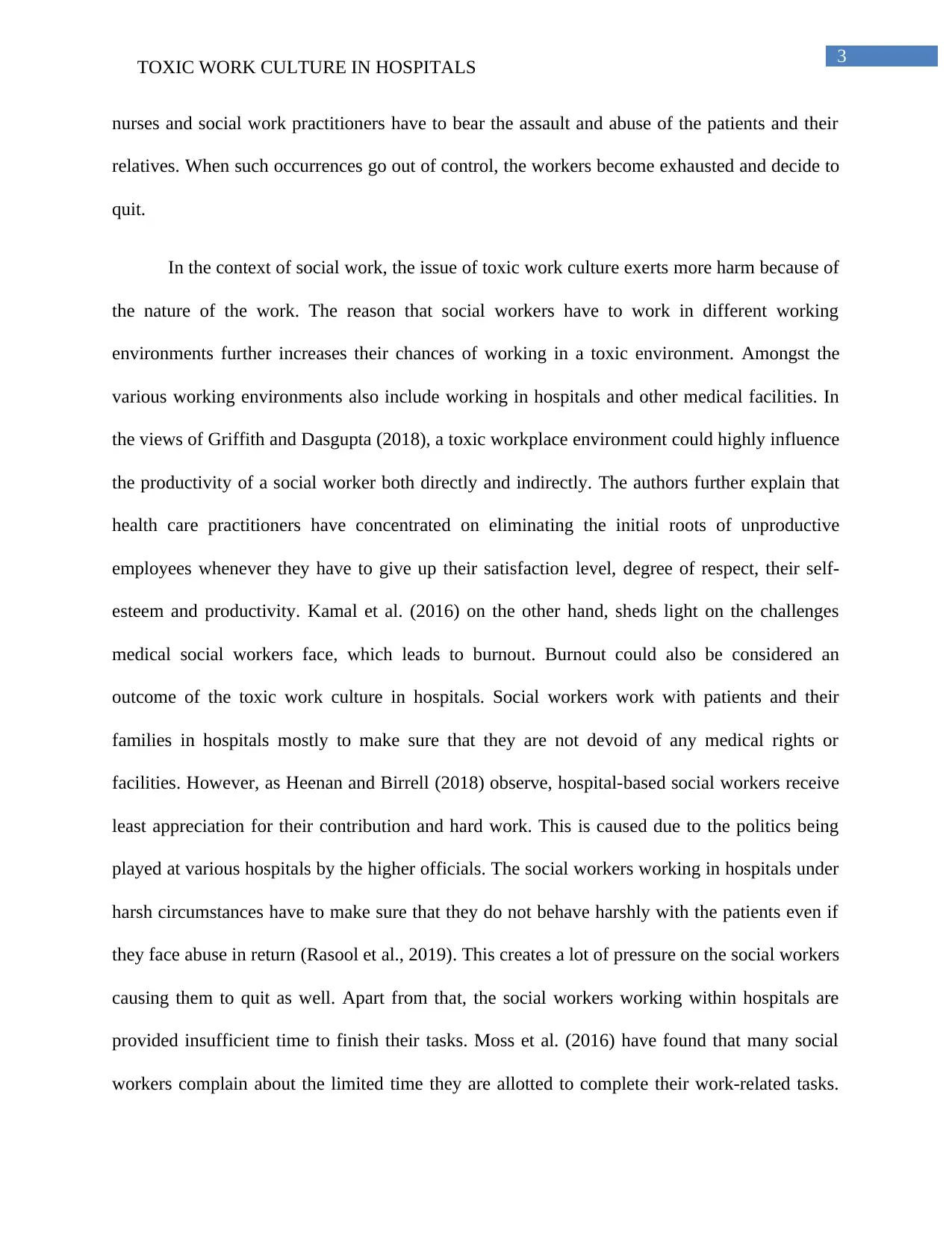
3
TOXIC WORK CULTURE IN HOSPITALS
nurses and social work practitioners have to bear the assault and abuse of the patients and their
relatives. When such occurrences go out of control, the workers become exhausted and decide to
quit.
In the context of social work, the issue of toxic work culture exerts more harm because of
the nature of the work. The reason that social workers have to work in different working
environments further increases their chances of working in a toxic environment. Amongst the
various working environments also include working in hospitals and other medical facilities. In
the views of Griffith and Dasgupta (2018), a toxic workplace environment could highly influence
the productivity of a social worker both directly and indirectly. The authors further explain that
health care practitioners have concentrated on eliminating the initial roots of unproductive
employees whenever they have to give up their satisfaction level, degree of respect, their self-
esteem and productivity. Kamal et al. (2016) on the other hand, sheds light on the challenges
medical social workers face, which leads to burnout. Burnout could also be considered an
outcome of the toxic work culture in hospitals. Social workers work with patients and their
families in hospitals mostly to make sure that they are not devoid of any medical rights or
facilities. However, as Heenan and Birrell (2018) observe, hospital-based social workers receive
least appreciation for their contribution and hard work. This is caused due to the politics being
played at various hospitals by the higher officials. The social workers working in hospitals under
harsh circumstances have to make sure that they do not behave harshly with the patients even if
they face abuse in return (Rasool et al., 2019). This creates a lot of pressure on the social workers
causing them to quit as well. Apart from that, the social workers working within hospitals are
provided insufficient time to finish their tasks. Moss et al. (2016) have found that many social
workers complain about the limited time they are allotted to complete their work-related tasks.
TOXIC WORK CULTURE IN HOSPITALS
nurses and social work practitioners have to bear the assault and abuse of the patients and their
relatives. When such occurrences go out of control, the workers become exhausted and decide to
quit.
In the context of social work, the issue of toxic work culture exerts more harm because of
the nature of the work. The reason that social workers have to work in different working
environments further increases their chances of working in a toxic environment. Amongst the
various working environments also include working in hospitals and other medical facilities. In
the views of Griffith and Dasgupta (2018), a toxic workplace environment could highly influence
the productivity of a social worker both directly and indirectly. The authors further explain that
health care practitioners have concentrated on eliminating the initial roots of unproductive
employees whenever they have to give up their satisfaction level, degree of respect, their self-
esteem and productivity. Kamal et al. (2016) on the other hand, sheds light on the challenges
medical social workers face, which leads to burnout. Burnout could also be considered an
outcome of the toxic work culture in hospitals. Social workers work with patients and their
families in hospitals mostly to make sure that they are not devoid of any medical rights or
facilities. However, as Heenan and Birrell (2018) observe, hospital-based social workers receive
least appreciation for their contribution and hard work. This is caused due to the politics being
played at various hospitals by the higher officials. The social workers working in hospitals under
harsh circumstances have to make sure that they do not behave harshly with the patients even if
they face abuse in return (Rasool et al., 2019). This creates a lot of pressure on the social workers
causing them to quit as well. Apart from that, the social workers working within hospitals are
provided insufficient time to finish their tasks. Moss et al. (2016) have found that many social
workers complain about the limited time they are allotted to complete their work-related tasks.
Paraphrase This Document
Need a fresh take? Get an instant paraphrase of this document with our AI Paraphraser
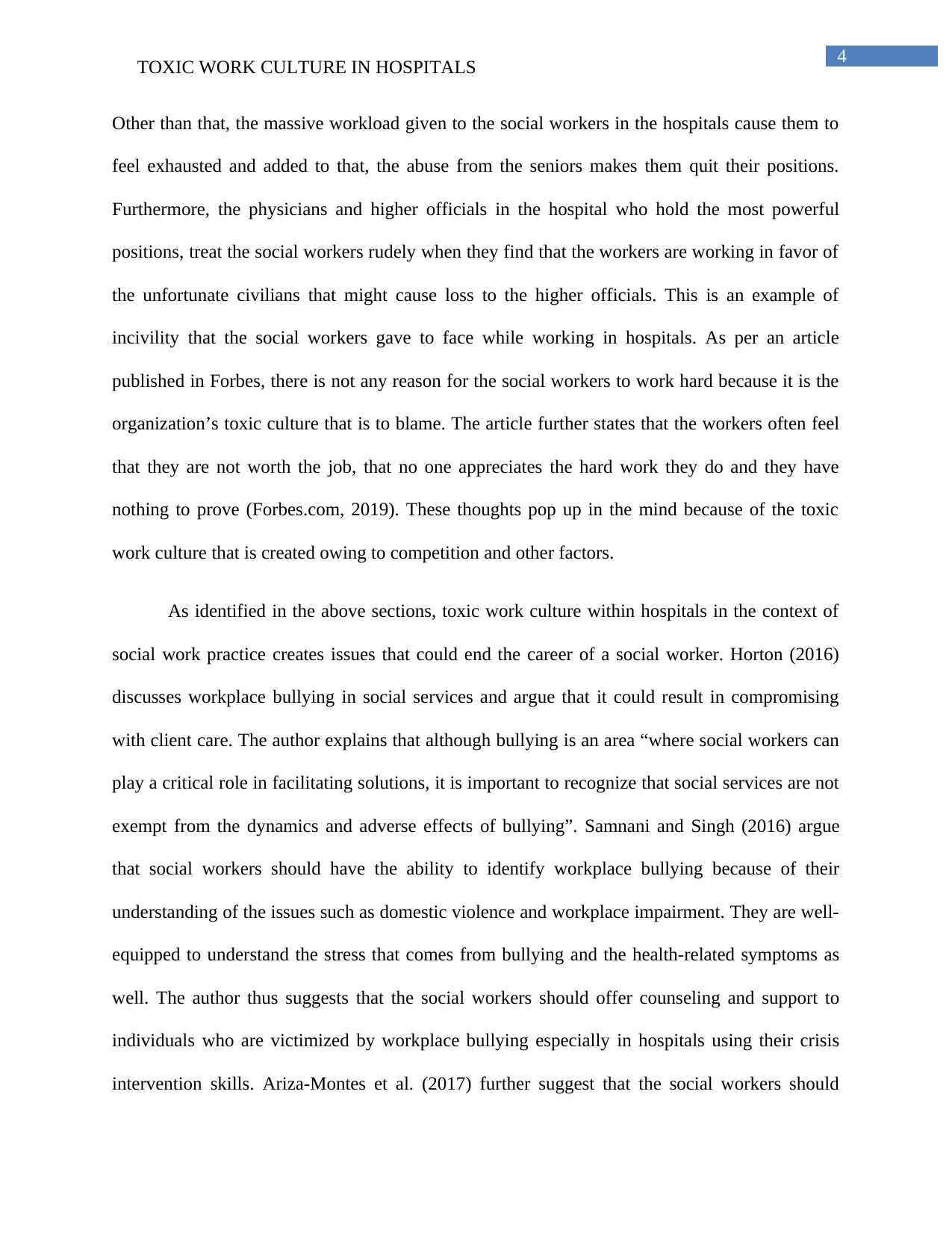
4
TOXIC WORK CULTURE IN HOSPITALS
Other than that, the massive workload given to the social workers in the hospitals cause them to
feel exhausted and added to that, the abuse from the seniors makes them quit their positions.
Furthermore, the physicians and higher officials in the hospital who hold the most powerful
positions, treat the social workers rudely when they find that the workers are working in favor of
the unfortunate civilians that might cause loss to the higher officials. This is an example of
incivility that the social workers gave to face while working in hospitals. As per an article
published in Forbes, there is not any reason for the social workers to work hard because it is the
organization’s toxic culture that is to blame. The article further states that the workers often feel
that they are not worth the job, that no one appreciates the hard work they do and they have
nothing to prove (Forbes.com, 2019). These thoughts pop up in the mind because of the toxic
work culture that is created owing to competition and other factors.
As identified in the above sections, toxic work culture within hospitals in the context of
social work practice creates issues that could end the career of a social worker. Horton (2016)
discusses workplace bullying in social services and argue that it could result in compromising
with client care. The author explains that although bullying is an area “where social workers can
play a critical role in facilitating solutions, it is important to recognize that social services are not
exempt from the dynamics and adverse effects of bullying”. Samnani and Singh (2016) argue
that social workers should have the ability to identify workplace bullying because of their
understanding of the issues such as domestic violence and workplace impairment. They are well-
equipped to understand the stress that comes from bullying and the health-related symptoms as
well. The author thus suggests that the social workers should offer counseling and support to
individuals who are victimized by workplace bullying especially in hospitals using their crisis
intervention skills. Ariza-Montes et al. (2017) further suggest that the social workers should
TOXIC WORK CULTURE IN HOSPITALS
Other than that, the massive workload given to the social workers in the hospitals cause them to
feel exhausted and added to that, the abuse from the seniors makes them quit their positions.
Furthermore, the physicians and higher officials in the hospital who hold the most powerful
positions, treat the social workers rudely when they find that the workers are working in favor of
the unfortunate civilians that might cause loss to the higher officials. This is an example of
incivility that the social workers gave to face while working in hospitals. As per an article
published in Forbes, there is not any reason for the social workers to work hard because it is the
organization’s toxic culture that is to blame. The article further states that the workers often feel
that they are not worth the job, that no one appreciates the hard work they do and they have
nothing to prove (Forbes.com, 2019). These thoughts pop up in the mind because of the toxic
work culture that is created owing to competition and other factors.
As identified in the above sections, toxic work culture within hospitals in the context of
social work practice creates issues that could end the career of a social worker. Horton (2016)
discusses workplace bullying in social services and argue that it could result in compromising
with client care. The author explains that although bullying is an area “where social workers can
play a critical role in facilitating solutions, it is important to recognize that social services are not
exempt from the dynamics and adverse effects of bullying”. Samnani and Singh (2016) argue
that social workers should have the ability to identify workplace bullying because of their
understanding of the issues such as domestic violence and workplace impairment. They are well-
equipped to understand the stress that comes from bullying and the health-related symptoms as
well. The author thus suggests that the social workers should offer counseling and support to
individuals who are victimized by workplace bullying especially in hospitals using their crisis
intervention skills. Ariza-Montes et al. (2017) further suggest that the social workers should
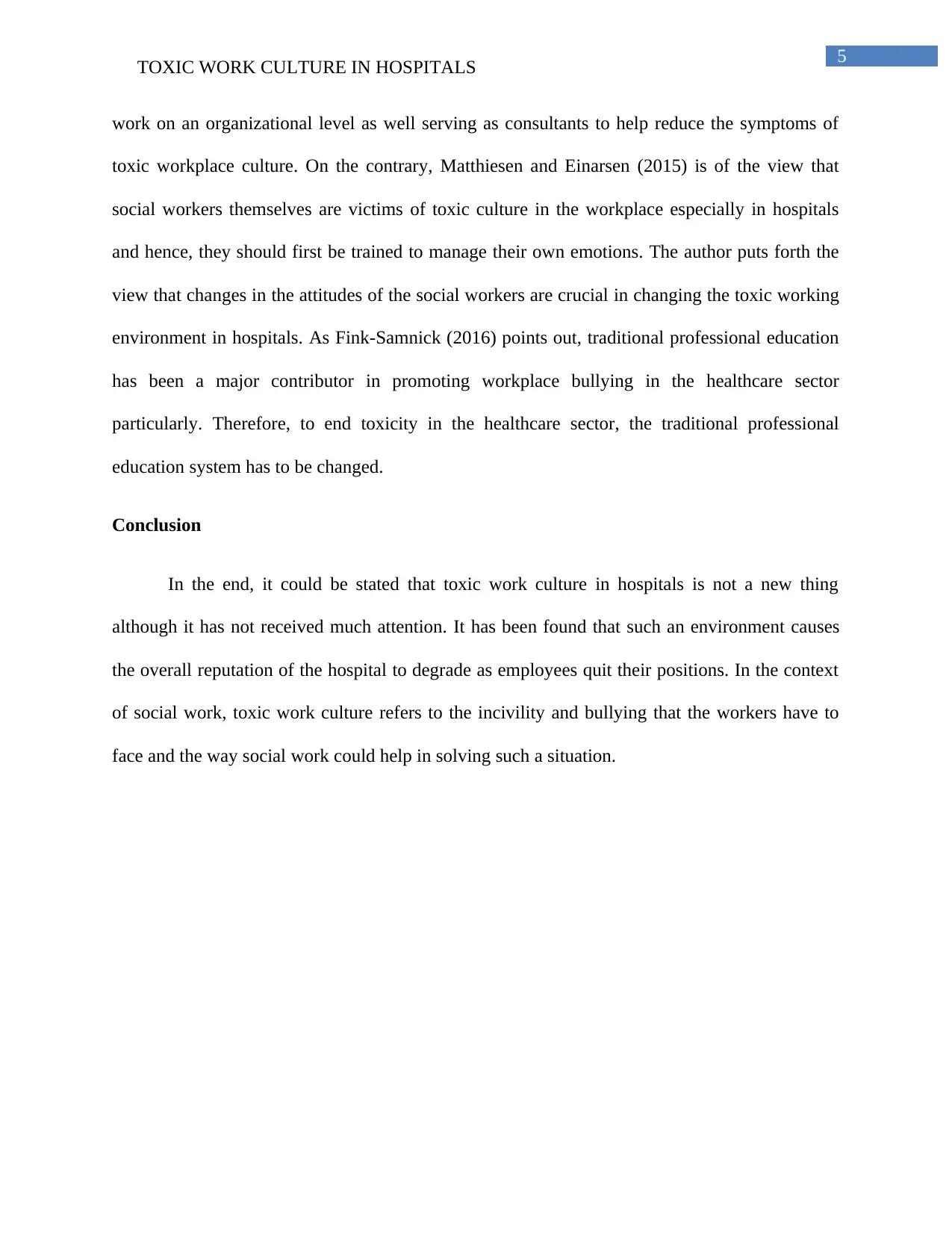
5
TOXIC WORK CULTURE IN HOSPITALS
work on an organizational level as well serving as consultants to help reduce the symptoms of
toxic workplace culture. On the contrary, Matthiesen and Einarsen (2015) is of the view that
social workers themselves are victims of toxic culture in the workplace especially in hospitals
and hence, they should first be trained to manage their own emotions. The author puts forth the
view that changes in the attitudes of the social workers are crucial in changing the toxic working
environment in hospitals. As Fink-Samnick (2016) points out, traditional professional education
has been a major contributor in promoting workplace bullying in the healthcare sector
particularly. Therefore, to end toxicity in the healthcare sector, the traditional professional
education system has to be changed.
Conclusion
In the end, it could be stated that toxic work culture in hospitals is not a new thing
although it has not received much attention. It has been found that such an environment causes
the overall reputation of the hospital to degrade as employees quit their positions. In the context
of social work, toxic work culture refers to the incivility and bullying that the workers have to
face and the way social work could help in solving such a situation.
TOXIC WORK CULTURE IN HOSPITALS
work on an organizational level as well serving as consultants to help reduce the symptoms of
toxic workplace culture. On the contrary, Matthiesen and Einarsen (2015) is of the view that
social workers themselves are victims of toxic culture in the workplace especially in hospitals
and hence, they should first be trained to manage their own emotions. The author puts forth the
view that changes in the attitudes of the social workers are crucial in changing the toxic working
environment in hospitals. As Fink-Samnick (2016) points out, traditional professional education
has been a major contributor in promoting workplace bullying in the healthcare sector
particularly. Therefore, to end toxicity in the healthcare sector, the traditional professional
education system has to be changed.
Conclusion
In the end, it could be stated that toxic work culture in hospitals is not a new thing
although it has not received much attention. It has been found that such an environment causes
the overall reputation of the hospital to degrade as employees quit their positions. In the context
of social work, toxic work culture refers to the incivility and bullying that the workers have to
face and the way social work could help in solving such a situation.
⊘ This is a preview!⊘
Do you want full access?
Subscribe today to unlock all pages.

Trusted by 1+ million students worldwide
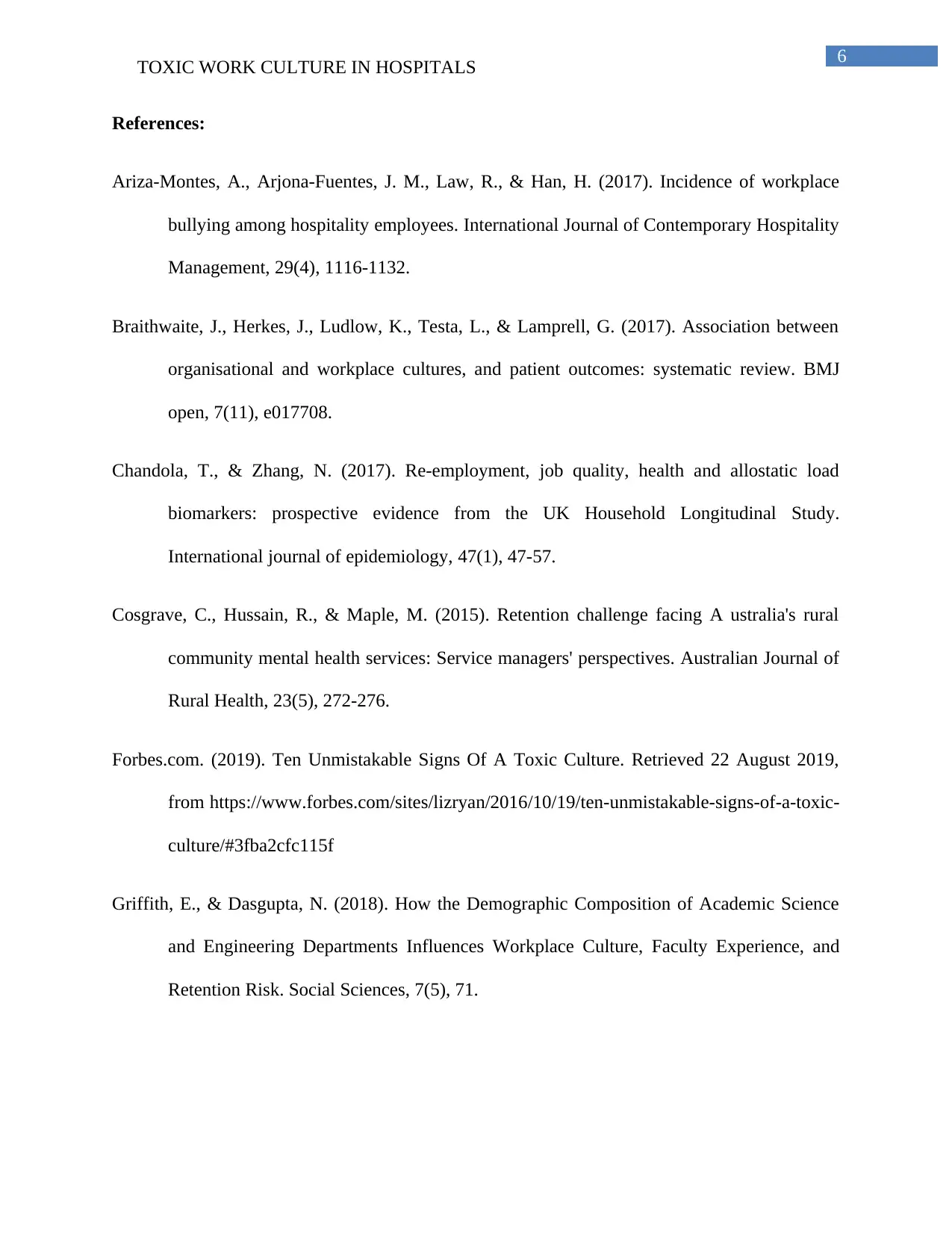
6
TOXIC WORK CULTURE IN HOSPITALS
References:
Ariza-Montes, A., Arjona-Fuentes, J. M., Law, R., & Han, H. (2017). Incidence of workplace
bullying among hospitality employees. International Journal of Contemporary Hospitality
Management, 29(4), 1116-1132.
Braithwaite, J., Herkes, J., Ludlow, K., Testa, L., & Lamprell, G. (2017). Association between
organisational and workplace cultures, and patient outcomes: systematic review. BMJ
open, 7(11), e017708.
Chandola, T., & Zhang, N. (2017). Re-employment, job quality, health and allostatic load
biomarkers: prospective evidence from the UK Household Longitudinal Study.
International journal of epidemiology, 47(1), 47-57.
Cosgrave, C., Hussain, R., & Maple, M. (2015). Retention challenge facing A ustralia's rural
community mental health services: Service managers' perspectives. Australian Journal of
Rural Health, 23(5), 272-276.
Forbes.com. (2019). Ten Unmistakable Signs Of A Toxic Culture. Retrieved 22 August 2019,
from https://www.forbes.com/sites/lizryan/2016/10/19/ten-unmistakable-signs-of-a-toxic-
culture/#3fba2cfc115f
Griffith, E., & Dasgupta, N. (2018). How the Demographic Composition of Academic Science
and Engineering Departments Influences Workplace Culture, Faculty Experience, and
Retention Risk. Social Sciences, 7(5), 71.
TOXIC WORK CULTURE IN HOSPITALS
References:
Ariza-Montes, A., Arjona-Fuentes, J. M., Law, R., & Han, H. (2017). Incidence of workplace
bullying among hospitality employees. International Journal of Contemporary Hospitality
Management, 29(4), 1116-1132.
Braithwaite, J., Herkes, J., Ludlow, K., Testa, L., & Lamprell, G. (2017). Association between
organisational and workplace cultures, and patient outcomes: systematic review. BMJ
open, 7(11), e017708.
Chandola, T., & Zhang, N. (2017). Re-employment, job quality, health and allostatic load
biomarkers: prospective evidence from the UK Household Longitudinal Study.
International journal of epidemiology, 47(1), 47-57.
Cosgrave, C., Hussain, R., & Maple, M. (2015). Retention challenge facing A ustralia's rural
community mental health services: Service managers' perspectives. Australian Journal of
Rural Health, 23(5), 272-276.
Forbes.com. (2019). Ten Unmistakable Signs Of A Toxic Culture. Retrieved 22 August 2019,
from https://www.forbes.com/sites/lizryan/2016/10/19/ten-unmistakable-signs-of-a-toxic-
culture/#3fba2cfc115f
Griffith, E., & Dasgupta, N. (2018). How the Demographic Composition of Academic Science
and Engineering Departments Influences Workplace Culture, Faculty Experience, and
Retention Risk. Social Sciences, 7(5), 71.
Paraphrase This Document
Need a fresh take? Get an instant paraphrase of this document with our AI Paraphraser
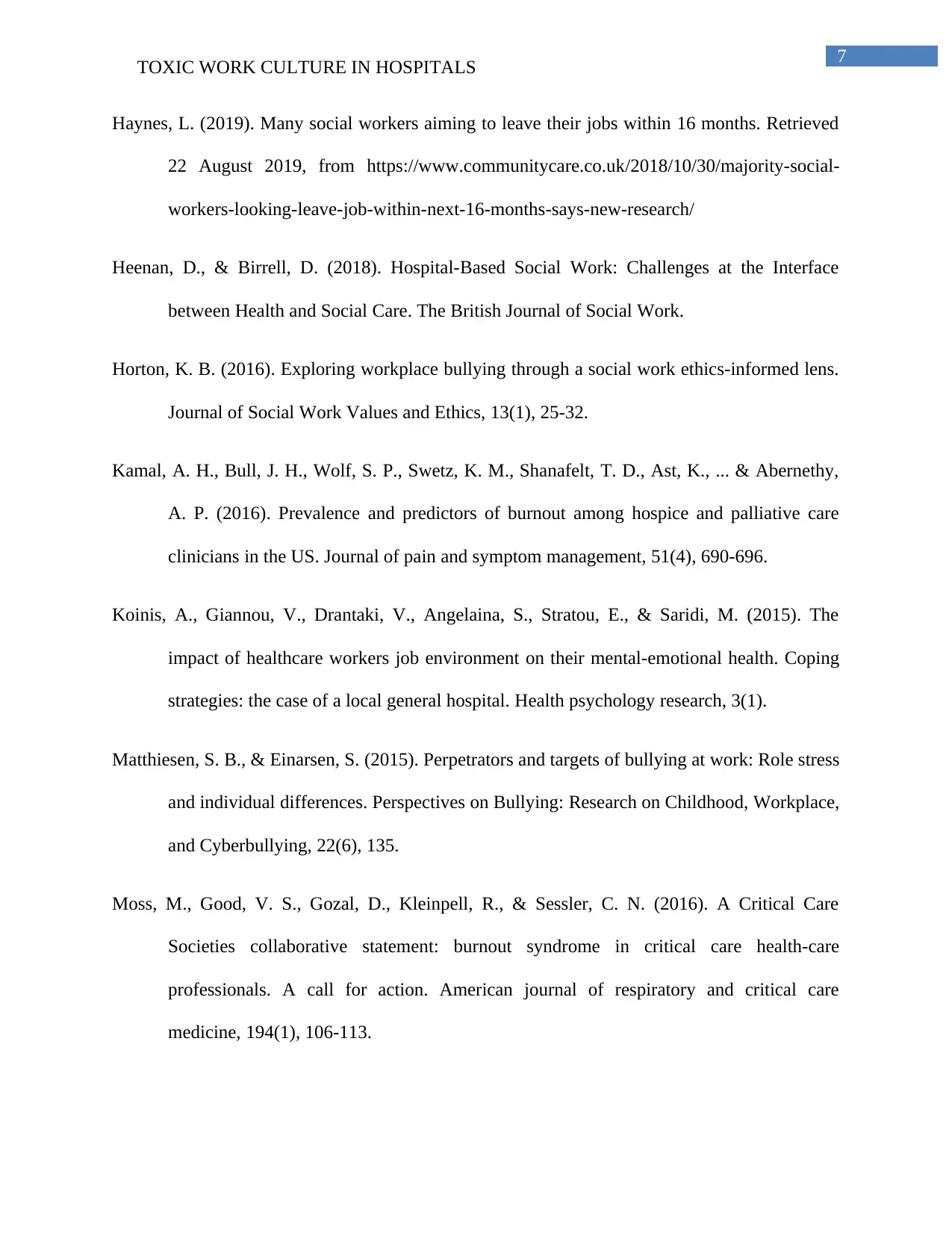
7
TOXIC WORK CULTURE IN HOSPITALS
Haynes, L. (2019). Many social workers aiming to leave their jobs within 16 months. Retrieved
22 August 2019, from https://www.communitycare.co.uk/2018/10/30/majority-social-
workers-looking-leave-job-within-next-16-months-says-new-research/
Heenan, D., & Birrell, D. (2018). Hospital-Based Social Work: Challenges at the Interface
between Health and Social Care. The British Journal of Social Work.
Horton, K. B. (2016). Exploring workplace bullying through a social work ethics-informed lens.
Journal of Social Work Values and Ethics, 13(1), 25-32.
Kamal, A. H., Bull, J. H., Wolf, S. P., Swetz, K. M., Shanafelt, T. D., Ast, K., ... & Abernethy,
A. P. (2016). Prevalence and predictors of burnout among hospice and palliative care
clinicians in the US. Journal of pain and symptom management, 51(4), 690-696.
Koinis, A., Giannou, V., Drantaki, V., Angelaina, S., Stratou, E., & Saridi, M. (2015). The
impact of healthcare workers job environment on their mental-emotional health. Coping
strategies: the case of a local general hospital. Health psychology research, 3(1).
Matthiesen, S. B., & Einarsen, S. (2015). Perpetrators and targets of bullying at work: Role stress
and individual differences. Perspectives on Bullying: Research on Childhood, Workplace,
and Cyberbullying, 22(6), 135.
Moss, M., Good, V. S., Gozal, D., Kleinpell, R., & Sessler, C. N. (2016). A Critical Care
Societies collaborative statement: burnout syndrome in critical care health-care
professionals. A call for action. American journal of respiratory and critical care
medicine, 194(1), 106-113.
TOXIC WORK CULTURE IN HOSPITALS
Haynes, L. (2019). Many social workers aiming to leave their jobs within 16 months. Retrieved
22 August 2019, from https://www.communitycare.co.uk/2018/10/30/majority-social-
workers-looking-leave-job-within-next-16-months-says-new-research/
Heenan, D., & Birrell, D. (2018). Hospital-Based Social Work: Challenges at the Interface
between Health and Social Care. The British Journal of Social Work.
Horton, K. B. (2016). Exploring workplace bullying through a social work ethics-informed lens.
Journal of Social Work Values and Ethics, 13(1), 25-32.
Kamal, A. H., Bull, J. H., Wolf, S. P., Swetz, K. M., Shanafelt, T. D., Ast, K., ... & Abernethy,
A. P. (2016). Prevalence and predictors of burnout among hospice and palliative care
clinicians in the US. Journal of pain and symptom management, 51(4), 690-696.
Koinis, A., Giannou, V., Drantaki, V., Angelaina, S., Stratou, E., & Saridi, M. (2015). The
impact of healthcare workers job environment on their mental-emotional health. Coping
strategies: the case of a local general hospital. Health psychology research, 3(1).
Matthiesen, S. B., & Einarsen, S. (2015). Perpetrators and targets of bullying at work: Role stress
and individual differences. Perspectives on Bullying: Research on Childhood, Workplace,
and Cyberbullying, 22(6), 135.
Moss, M., Good, V. S., Gozal, D., Kleinpell, R., & Sessler, C. N. (2016). A Critical Care
Societies collaborative statement: burnout syndrome in critical care health-care
professionals. A call for action. American journal of respiratory and critical care
medicine, 194(1), 106-113.
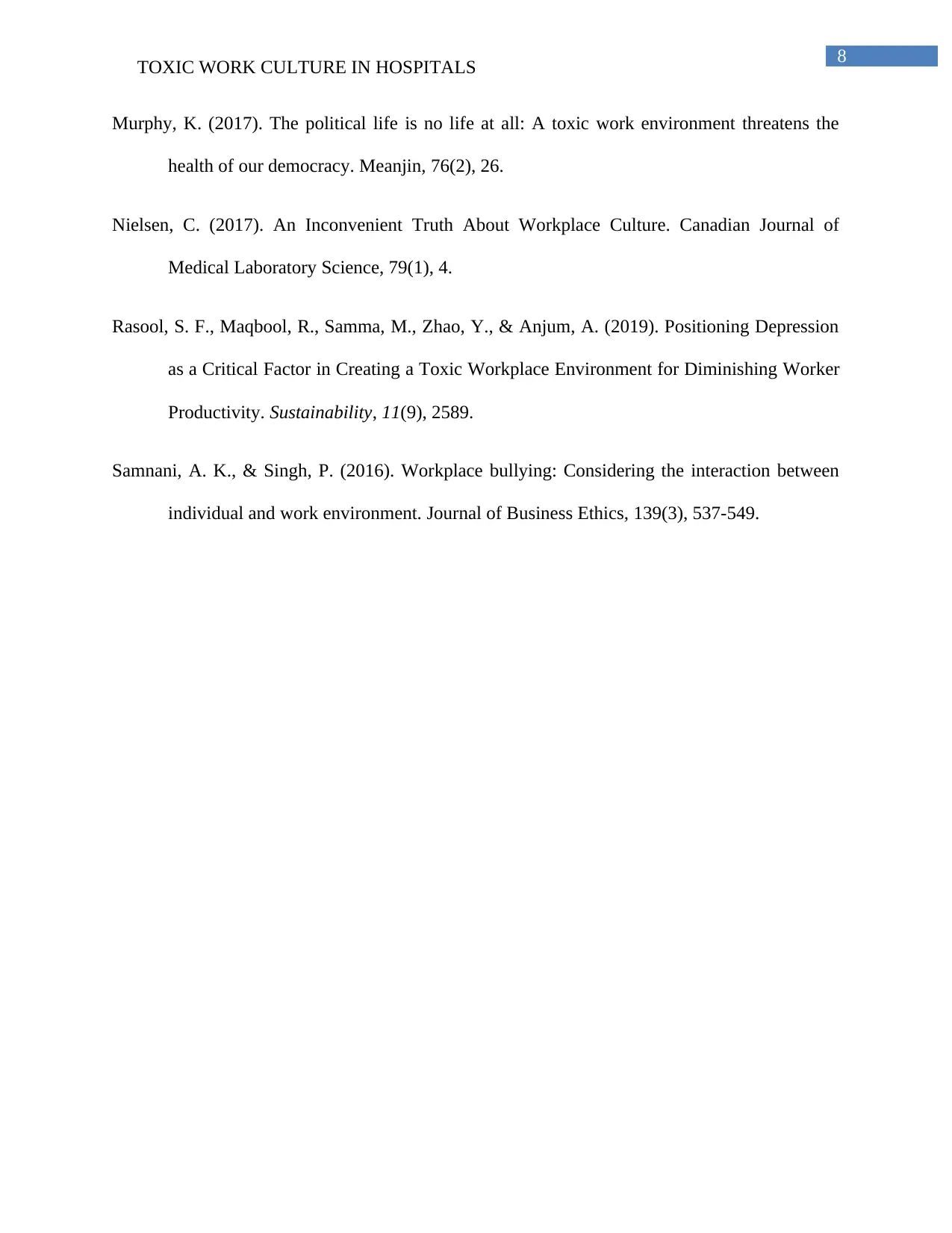
8
TOXIC WORK CULTURE IN HOSPITALS
Murphy, K. (2017). The political life is no life at all: A toxic work environment threatens the
health of our democracy. Meanjin, 76(2), 26.
Nielsen, C. (2017). An Inconvenient Truth About Workplace Culture. Canadian Journal of
Medical Laboratory Science, 79(1), 4.
Rasool, S. F., Maqbool, R., Samma, M., Zhao, Y., & Anjum, A. (2019). Positioning Depression
as a Critical Factor in Creating a Toxic Workplace Environment for Diminishing Worker
Productivity. Sustainability, 11(9), 2589.
Samnani, A. K., & Singh, P. (2016). Workplace bullying: Considering the interaction between
individual and work environment. Journal of Business Ethics, 139(3), 537-549.
TOXIC WORK CULTURE IN HOSPITALS
Murphy, K. (2017). The political life is no life at all: A toxic work environment threatens the
health of our democracy. Meanjin, 76(2), 26.
Nielsen, C. (2017). An Inconvenient Truth About Workplace Culture. Canadian Journal of
Medical Laboratory Science, 79(1), 4.
Rasool, S. F., Maqbool, R., Samma, M., Zhao, Y., & Anjum, A. (2019). Positioning Depression
as a Critical Factor in Creating a Toxic Workplace Environment for Diminishing Worker
Productivity. Sustainability, 11(9), 2589.
Samnani, A. K., & Singh, P. (2016). Workplace bullying: Considering the interaction between
individual and work environment. Journal of Business Ethics, 139(3), 537-549.
⊘ This is a preview!⊘
Do you want full access?
Subscribe today to unlock all pages.

Trusted by 1+ million students worldwide
1 out of 9
Your All-in-One AI-Powered Toolkit for Academic Success.
+13062052269
info@desklib.com
Available 24*7 on WhatsApp / Email
![[object Object]](/_next/static/media/star-bottom.7253800d.svg)
Unlock your academic potential
Copyright © 2020–2025 A2Z Services. All Rights Reserved. Developed and managed by ZUCOL.
